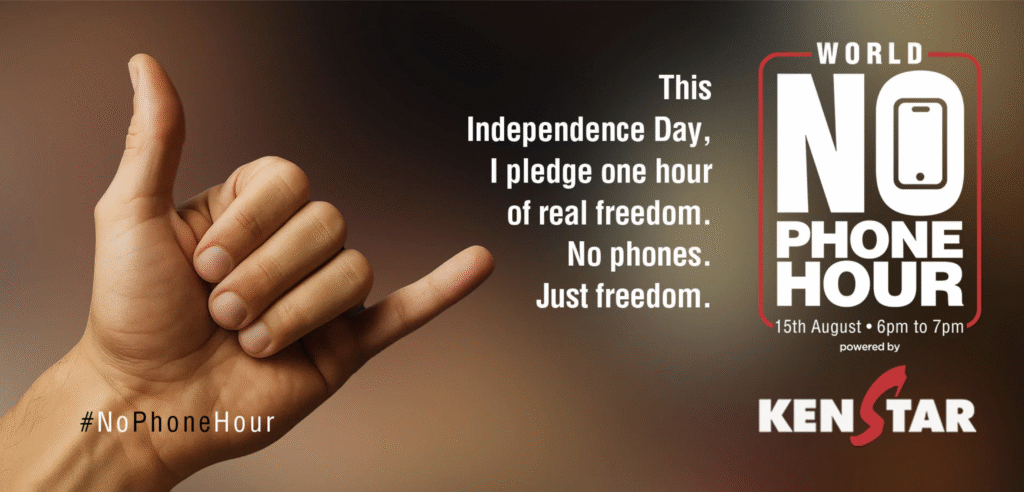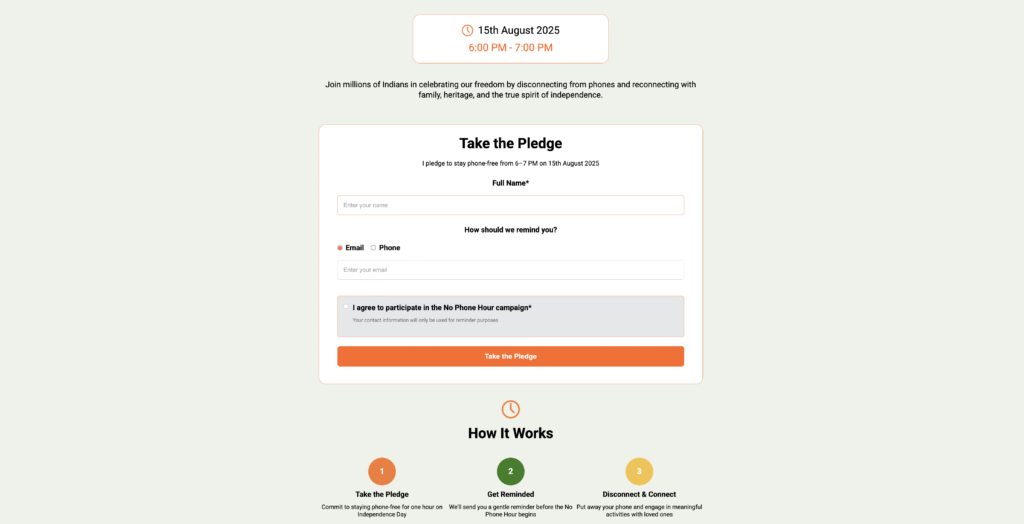- The Architecture of Contemporary Contradiction
- The Cultural Moment We Inhabit
- The Psychology of Patriotic Paradox
- Independence Day as Strategic Territory
- The Business Strategy Revealed
- The Measurement Paradox
- The Broader Cultural Commentary
- Strategic Lessons for Marketing Professionals
- The Deeper Strategic Game
- The Future of Paradoxical Marketing
- The Immediate Future

Yesterday or the day before (not sure), as Kenstar unveiled its “No Phone Hour” campaign for Independence Day, the irony wasn’t lost on anyone—least of all the home appliances brand that had just executed one of the year’s most fascinating exercises in cognitive dissonance.
The timing couldn’t have been more perfect. As August settles into its final weeks and India prepares for its 78th Independence Day celebration, Kenstar has launched an initiative that asks Indians to pledge digital abstinence through… digital means. To celebrate freedom by logging off. To reconnect by first connecting to their website123.
Welcome to the authenticity paradox of contemporary marketing, where the medium inevitably devours the message, and yet somehow, the entire enterprise works brilliantly.
The Architecture of Contemporary Contradiction
Kenstar’s campaign, launched just yesterday, operates on multiple levels of strategic irony12. The brand, traditionally known for cooling solutions in India’s sweltering heat, has positioned itself as an antidote to digital overheating. Their messaging strikes with elegant simplicity: “No phone Hour. Just freedom.” The visual identity features a hand gesture replacing a phone—a stark metaphor rendered in pixels and distributed via algorithms2.
CEO Sunil Jain frames the initiative as “more than just a campaign, it’s a call to reflect on what freedom truly means in today’s world”12. Yet this reflection requires digital participation: signing pledges online, sharing experiences using #NoPhoneHour, and engaging with social media amplification. The campaign’s intended success—measured through media coverage and online engagement—directly contradicts its core premise.
This isn’t accidental marketing myopia. It’s strategic genius masquerading as contradiction.
The Cultural Moment We Inhabit
To grasp Kenstar’s gambit, you must first understand the digital landscape it inhabits. India, with over 750 million smartphone users, represents a nation simultaneously connected and profoundly disconnected4. Recent research reveals that Indians spend an average of 4.7 hours daily on mobile devices, with 70% of that time devoted to social media, gaming, and video consumption4. Among young adults aged 18-30, smartphone addiction rates hover around 25%5, whilst broader studies suggest prevalence rates reaching 33% among adolescents6.
The timing proves exquisite. Independence Day in India isn’t merely a national holiday—it’s an emotional amplification chamber where brands compete for patriotic authenticity7. The day generates increased consumer spending and emotional receptivity, making it fertile ground for campaigns that link commercial objectives to cultural values87.
Kenstar’s insight lies in recognising that digital fatigue has become its own form of contemporary colonisation—a modern unfreedom that could be positioned against India’s historic struggle for independence.
By linking smartphone addiction to lost sovereignty, they’ve transformed a home appliances brand into a digital liberation movement.
The Psychology of Patriotic Paradox
Modern marketing faces what scholars term the “authenticity paradox”—the impossible demand to appear genuinely real whilst simultaneously being strategically constructed910. Consumers increasingly distrust brands that seem too polished, yet they equally reject those that appear genuinely unpolished. The solution lies in what researchers call “strategic authenticity”—the careful curation of seemingly genuine moments.
Kenstar’s campaign embodies this paradox perfectly. The brand’s commitment to digital detox is simultaneously real and performative. Real, because digital overwhelm represents a genuine consumer concern affecting mental health and social connections116. Performative, because addressing it requires the very digital infrastructure they critique.
Yet this contradiction doesn’t diminish the campaign’s potential effectiveness—it enhances it. In an era where authenticity has become performatively curated, consumers appreciate brands that acknowledge complexity over those claiming simple solutions9.
Independence Day as Strategic Territory
Independence Day campaigns in India succeed not through logical coherence but through emotional resonance. Research into patriotic advertising reveals that themes around “freedom and democracy” and “cultural diversity and harmony” generate the strongest positive responses from Indian consumers12. Interestingly, campaigns emphasising “prosperous future and development” often produce negative effects—suggesting Indians respond more strongly to values-based appeals than economic promises1213.
Kenstar’s genius lies in redefining freedom for the digital age. Traditional Independence Day campaigns focus on historical liberation; Kenstar focuses on contemporary enslavement.
They don’t ask consumers to celebrate past freedom—they ask them to reclaim present agency.
The psychological mechanism involves what researchers call “nostalgic patriotism”—the tendency to romanticise not just national history but personal autonomy1415. By positioning smartphones as contemporary colonisers, Kenstar taps into deep-seated narratives about Indian resistance whilst appearing thoroughly modern.
The Business Strategy Revealed

For a home appliances brand expanding into smart products—Kenstar launched its full range of large appliances in 202416—the digital detox positioning might seem commercially suicidal. Why advocate disconnection when your business increasingly depends on connectivity?
The answer reveals sophisticated brand strategy. Kenstar isn’t positioning itself against technology—it’s positioning itself as technology that serves human needs rather than enslaving them. In a market where smart appliance penetration has doubled since 2020, and major brands expect AI-powered products to constitute 50% of sales by 2025-2617, Kenstar differentiates itself through mindful technology.
This positioning addresses a crucial consumer concern. Whilst the smart home market in India is projected to reach $19.31 billion by 203018, growing consumer awareness of digital addiction creates demand for brands that acknowledge the problem.
Kenstar positions itself not as another smart device manufacturer, but as a curator of intelligent living—technology that enhances rather than dominates.
The Measurement Paradox
Traditional marketing metrics—engagement rates, social shares, website traffic—become philosophically problematic when applied to digital detox campaigns.

How do you measure the success of a campaign advocating digital abstinence? Through digital metrics, naturally.
The campaign’s early success—significant media coverage across platforms123, social media engagement via #NoPhoneHour1, and traffic to their pledge website19—highlights a fundamental challenge in contemporary marketing: the impossibility of measuring authentic engagement through inauthentic metrics.
Yet Kenstar’s approach suggests consumers are comfortable with this paradox. They don’t demand perfect consistency—they demand acknowledged complexity.
The Broader Cultural Commentary
Kenstar’s campaign arrives at a cultural inflection point. The global digital detox movement, valued at $52.32 billion in 2024 and projected to reach $466.58 billion by 203420, reflects growing anxiety about technology’s psychological impact. In India specifically, research reveals that smartphone addiction correlates with increased depression rates among young adults21.
The campaign intersects with rising consumer consciousness about mindful consumption. As urbanisation accelerates and digital fatigue intensifies, digital detox initiatives and mindful technology use become aspirational lifestyle choices11.
Kenstar positions itself at the intersection of these trends, appearing both contemporary and timeless.
They advocate for digital minimalism whilst building digital engagement—a contradiction that somehow feels more honest than straightforward consistency.
Strategic Lessons for Marketing Professionals
Kenstar’s campaign offers profound insights for navigating the authenticity paradox:
Embrace Strategic Contradiction: Rather than avoiding inconsistencies, acknowledge them. Consumers increasingly appreciate brands that recognise complexity over those claiming simplicity.
Cultural Context as Competitive Advantage: Independence Day provides emotional amplification that transforms routine campaigns into cultural conversations. Success lies in finding authentic connections between brand purpose and cultural moments78.
Purpose-Driven Marketing’s Evolution: Traditional purpose-driven marketing often feels forced because it claims perfect alignment between commercial and social objectives. Kenstar’s approach acknowledges the tension, making it more credible22.
Metrics vs. Meaning: Success metrics must evolve beyond traditional digital engagement to capture longer-term brand sentiment and cultural resonance. The campaign’s true value lies not in immediate metrics but in positioning for future market evolution.
The Paradox as Feature: Modern consumers don’t expect brands to be perfect—they expect honesty about imperfection. Kenstar’s digital detox campaign succeeds precisely because it acknowledges its contradictions.
The Deeper Strategic Game
Beneath Kenstar’s surface contradiction lies sophisticated strategic thinking. The brand isn’t genuinely advocating digital detox—it’s positioning itself as the curator of mindful technology. In a market increasingly cluttered with smart devices, Kenstar differentiates through wisdom rather than mere intelligence.
The campaign demonstrates evolved understanding of Indian consumer psychology. Rather than treating patriotism as simple nationalism, Kenstar recognises it as complex emotional architecture encompassing personal autonomy, cultural authenticity, and technological sovereignty1315.
Most crucially, the campaign reveals how authenticity functions in contemporary marketing.
It’s not about consistency—it’s about consciousness. Not about avoiding contradictions—but acknowledging them gracefully.
The Future of Paradoxical Marketing
Kenstar’s “No Phone Hour” campaign represents more than clever Independence Day marketing—it’s a glimpse into marketing’s future trajectory. As consumers become increasingly sophisticated about brand communications, traditional approaches to authenticity become liabilities.
The brands that thrive will acknowledge complexity rather than claim simplicity.
The campaign suggests successful contemporary marketing requires philosophical sophistication. Brands must understand not just what consumers want, but why they want contradictory things simultaneously. They must recognise that modern consumers don’t seek perfect brands—they seek honest ones.
In an attention economy built on contradiction—where we crave connection whilst feeling overwhelmed by connectivity—brands like Kenstar succeed by naming the paradox rather than resolving it. They offer not solutions but companionship in complexity.
The Immediate Future
As we move towards 15th August, Kenstar’s campaign will face its ultimate test. Will Indians actually switch off their phones from 6pm to 7pm? The question misses the point entirely. The campaign’s true success lies not in behavioural change but in cultural conversation—positioning Kenstar as a brand that understands contemporary anxiety whilst offering gentle guidance rather than harsh judgment.
The genius of Kenstar’s campaign isn’t asking Indians to disconnect from their phones. It’s helping them connect with the discomfort of never being able to fully disconnect.
In that shared recognition of digital-age anxiety, a brand selling air coolers becomes something more valuable: a voice of understanding in an increasingly bewildering world.
In our age of authenticity paradox, perhaps the most authentic thing a brand can do is acknowledge that authenticity itself has become impossible—whilst continuing to reach for it anyway. Kenstar’s campaign, launched into this cultural moment, suggests that consumers are ready for brands brave enough to embrace the contradiction rather than resolve it.
The “No Phone Hour” hasn’t happened yet, but the conversation about digital wellness, brand authenticity, and marketing contradictions has already begun. And perhaps that’s the real liberation Kenstar offers—not from our phones, but from the pretence that marketing can ever be perfectly consistent in an inconsistent world.
Sources:
- https://www.medianews4u.com/kenstar-urges-citizens-to-switch-off-phones-for-an-hour-on-15-aug-to-reconnect-with-loved-ones/
- https://mediabrief.com/kenstar-launches-no-phone-hour-campaign-to-encourage-digital-detox-and-meaningful-connections/
- https://smestreet.in/msmenews/kenstar-launches-no-phone-hour-for-independence-day-9629290
- https://timesofindia.indiatimes.com/life-style/spotlight/digital-detox-helps-unplug-unwind-on-weekends/articleshow/121846489.cms
- https://pmc.ncbi.nlm.nih.gov/articles/PMC11198534/
- https://pmc.ncbi.nlm.nih.gov/articles/PMC9067330/
- https://vwo.com/blog/indian-brands-drive-conversions-independence-day/
- https://www.kofluence.com/independence-day-marketing-ideas-to-boost-sales/
- https://terakeet.com/blog/brand-authenticity-in-content-marketing/
- https://globalcoachinglab.com/building-a-personal-brand-without-losing-yourself/
- https://pmc.ncbi.nlm.nih.gov/articles/PMC11109987/
- https://www.aasmr.org/liss/Vol.11/No.2/Vol.11.No.2.14.pdf
- http://drr.vau.ac.lk/bitstream/handle/123456789/65/JBM-vol04-iss-02-33-55.pdf?sequence=1&isAllowed=y
- https://ignited.in/index.php/jasrae/article/view/12549
- https://www.financialexpress.com/business/brandwagon-is-nation-building-the-new-buzzword-for-indian-brands-2627848/
- https://mediabrief.com/kenstar-launches-full-range-of-large-home-appliances/
- https://www.financialexpress.com/business/digital-transformation-consumer-brands-cashing-in-on-smart-home-dream-3632237/
- https://inc42.com/startups/here-are-8-d2c-brands-spearheading-smart-home-revolution-in-india/
- https://kenstar.in/pages/no-phone-hour
- https://www.polarismarketresearch.com/industry-analysis/digital-detox-tourism-services-market
- https://www.iapsmupuk.org/journal/index.php/IJCH/article/view/2477
- https://www.forbes.com/councils/forbesbusinessdevelopmentcouncil/2025/02/25/why-promoting-digital-detox-campaigns-is-good-business/
- https://www.mediainfoline.com/tag/digital-detox
- https://www.mediainfoline.com/tag/no-phone-hour
- https://www.mediainfoline.com/tag/family-connection
- https://forumias.com/blog/digital-detox-initiative/
- https://smestreet.in/author/smestreet-edit-desk-kr
- https://en.wikipedia.org/wiki/Digital_detox
- https://andhraguide.com
- https://www.instagram.com/p/DM1vVoHz83u/
- https://www.digitaldetoxday.org
- https://economictimes.com/archivelist/year-2024,month-9,starttime-45538.cms
- https://www.instagram.com/p/C-rUdeDvTAo/?__d=11
- https://www.mediainfoline.com/uncategorized/konami-efootball-announces-star-studded-india-campaign-featuring-kl-rahul-sunil-chhetri-and-ahan-shetty
- https://sea.mashable.com/tech/37970/digital-detox-for-the-next-generation-from-pouches-to-phone-free-proms
- https://x.com/ReleaseFor/status/1952713476280860724
- https://advance.sagepub.com/users/487327/articles/742827-world-digital-detox-day-a-global-movement-to-address-digital-dependency
